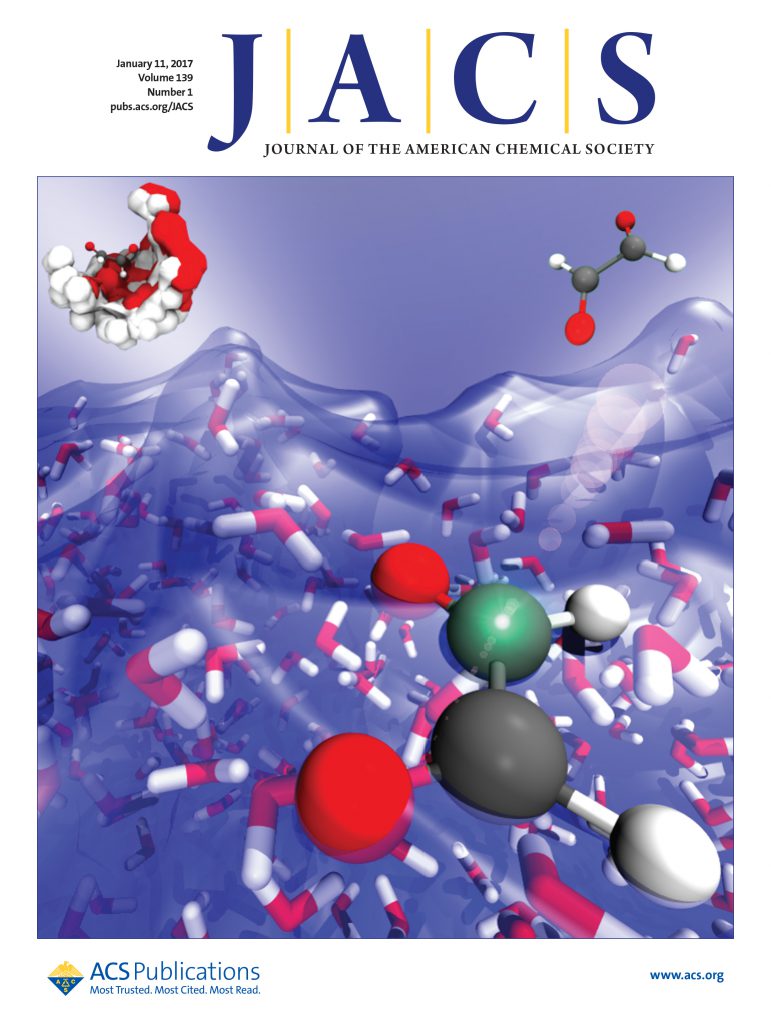具有实验相关成分的电喷雾液滴中天然蛋白质充电的分子动力学模拟
IF 14.4
1区 化学
Q1 CHEMISTRY, MULTIDISCIPLINARY
引用次数: 0
摘要
电喷雾电离质谱法(ESI-MS)被广泛应用于蛋白质研究,因为它在过渡到气相时可以保存天然蛋白质结构。了解实验因素对ESI的影响可以帮助我们深入了解最终的电荷状态,以及“原生”结构的维持程度。在实验上,表征纳米级电喷涂液滴具有挑战性;然而,分子动力学(MD)模拟通过提供蛋白质形成的分子视角提出了一个有吸引力的解决方案。通过解决过去ESI的MD模拟中使用的许多近似,我们证明了用实验相关的液滴组成和行为模拟电喷涂液滴的能力。这是通过模拟大气条件下模拟液滴中所有可滴定分子之间的质子转移来完成的;因此,使含有乙酸铵的模拟液滴能够形成实验观察到的(去)质子化的蛋白质离子。将所提出的方案应用于几种天然蛋白质的正离子和负离子模式ESI,得到了与实验值相比相差0.14的电荷态分布的模拟加权平均值。我们的模拟表明,在向气相过渡的过程中,残基碱度的变化在调节天然esi过程中的蛋白质充电中起着重要作用,并且可以解释许多实验观察到的趋势。通过模拟模型生成的离子蛋白结构相对于溶液结构平均保持了73%的天然接触到气相。当应用于原生蛋白质时,对气相过渡效应的新见解使人们能够更深入地了解ESI过程本身,因此,无论分析物如何,都具有丰富的信息。本文章由计算机程序翻译,如有差异,请以英文原文为准。

Molecular Dynamics Simulations of Native Protein Charging in Electrosprayed Droplets with Experimentally Relevant Compositions
Electrospray ionization-mass spectrometry (ESI-MS) has been widely used to study proteins given its preservation of native-protein structure when transitioning to the gas-phase. Understanding the influence of experimental factors on ESI can provide insight into the resulting charge states, as well as the degree to which “native” structure is maintained. Experimentally, it is challenging to characterize nanometer-scale electrosprayed droplets; however, molecular dynamics (MD) simulations pose an attractive solution by providing a molecular perspective of protein-ion formation. By resolving many approximations used in past MD simulations of ESI, we demonstrate the capability of simulating electrosprayed droplets with experimentally relevant droplet compositions and behavior. This is accomplished by modeling proton transfers between all titratable molecules in simulated droplets under atmospheric conditions; thus, enabling simulated droplets containing ammonium acetate that form experimentally observed (de)protonated protein ions. Application of the proposed protocol to several native proteins in positive- and negative-ion mode ESI produced simulated weighted averages of charge-state distributions that differed by 0.14 compared to experimental values. Our simulations suggest that changes in residue basicity during the transition to the gas-phase play a significant role in moderating protein charging during native-ESI and can explain many experimentally observed trends. Ionic protein structures produced via the simulated model maintained, on average, 73% of their native contacts into the gas phase relative to solution-phase structures. While applied towards native proteins here, novel insights into effects of the transition to gas-phase enable a deeper understanding of the ESI process itself and thus, are informative regardless of analyte.
求助全文
通过发布文献求助,成功后即可免费获取论文全文。
去求助
来源期刊
CiteScore
24.40
自引率
6.00%
发文量
2398
审稿时长
1.6 months
期刊介绍:
The flagship journal of the American Chemical Society, known as the Journal of the American Chemical Society (JACS), has been a prestigious publication since its establishment in 1879. It holds a preeminent position in the field of chemistry and related interdisciplinary sciences. JACS is committed to disseminating cutting-edge research papers, covering a wide range of topics, and encompasses approximately 19,000 pages of Articles, Communications, and Perspectives annually. With a weekly publication frequency, JACS plays a vital role in advancing the field of chemistry by providing essential research.

 求助内容:
求助内容: 应助结果提醒方式:
应助结果提醒方式:


